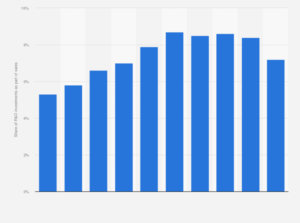India is a major player in the global pharmaceutical sector, with the largest supply of non-patented medicines and providing 20% of the world’s generic drug exports. According to the “Indian Economic Survey 2021,” India’s pharmaceutical market was estimated at $42 billion in 2021, and it could triple over the next decade. India’s pharmaceutical industry is now aiming to advance further in the global pharmaceutical value chain by investing in research and development (R&D), drug repurposing, and improving processes and digital production.

Government Support for Research and Development of Medicines
The Indian government aims to make India not only a global leader in the production of non-patented drugs but also a hub for pharmaceutical innovation through end-to-end discovery of medicines, including all stages from target identification to candidate drug creation. The “Pharma Vision 2020” initiative aims to support India’s pharmaceutical industry in becoming a center for pharmaceutical innovation.
The Indian government’s Department of Health Research at the Ministry of Health and Family Welfare has been allocated INR 32 billion ($419.2 million) for 2022-2023 from the Union budget of India. The department’s tasks include coordinating and promoting clinical research in the field of medicine. The Union budget for 2023-2024 also includes INR 20 billion for the National Research Foundation, which supports India’s research capabilities.
New Program to Support Research and Innovation in Pharma
In presenting the Union Budget 2023-2024, Finance Minister Nirmala Sitharaman announced a new program to support research and innovation in pharmaceuticals through centers of excellence. The Indian government intends to encourage the industry and provide a conducive environment for the discovery and development of new drugs. This program will focus on creating an ecosystem for innovation, including incubation centers and research parks, to support the development of pharmaceutical products and medical devices. India’s pharmaceutical industry has a promising future, with a robust R&D ecosystem and government support for innovation and research.
R&D Related to COVID-19 in India
In April 2021, the Department of Biotechnology, Ministry of Science & Technology, approved additional funding for the clinical trials of India’s first mRNA-based vaccine for COVID-19 prevention, called HGCO19. Gennova Biopharmaceuticals is developing this vaccine.
In July 2021, five Indian pharmaceutical companies (Cipla Ltd, Dr. Reddy’s, Sun Pharma, Torrent Pharma, and Emcure Pharmaceuticals) participated in clinical trials of molnupiravir for the treatment of moderately ill COVID-19 patients. BDR Pharmaceuticals also collaborated with the Defence Research and Development Organisation to produce drugs for coronavirus disease in India.
It is worth noting that during the coronavirus pandemic, Indian doctors had to fight not only this infection. Patients with COVID-19 (or those who have recovered) often developed mucormycosis, also known as “black fungus.” In May 2021, five pharmaceutical companies received approval from the Drugs Controller General of India to produce amphotericin B for the treatment of patients with mucormycosis.
In addition to these developments, India has made significant strides in R&D related to COVID-19. Indian scientists have developed a low-cost diagnostic kit, Feluda, that can detect COVID-19 in less than an hour. They have also developed a drug called 2-DG, which has been shown to reduce the recovery time of COVID-19 patients.
Furthermore, India is one of the leading countries in the world in terms of COVID-19 vaccine production. Two vaccines developed in India, Covishield and Covaxin, have been approved for emergency use and are being used in several countries worldwide. Several other Indian companies are also developing COVID-19 vaccines.
Overall, India’s R&D efforts related to COVID-19 have been extensive and diverse, reflecting the country’s commitment to fighting the pandemic and developing solutions to combat infectious diseases in the future.